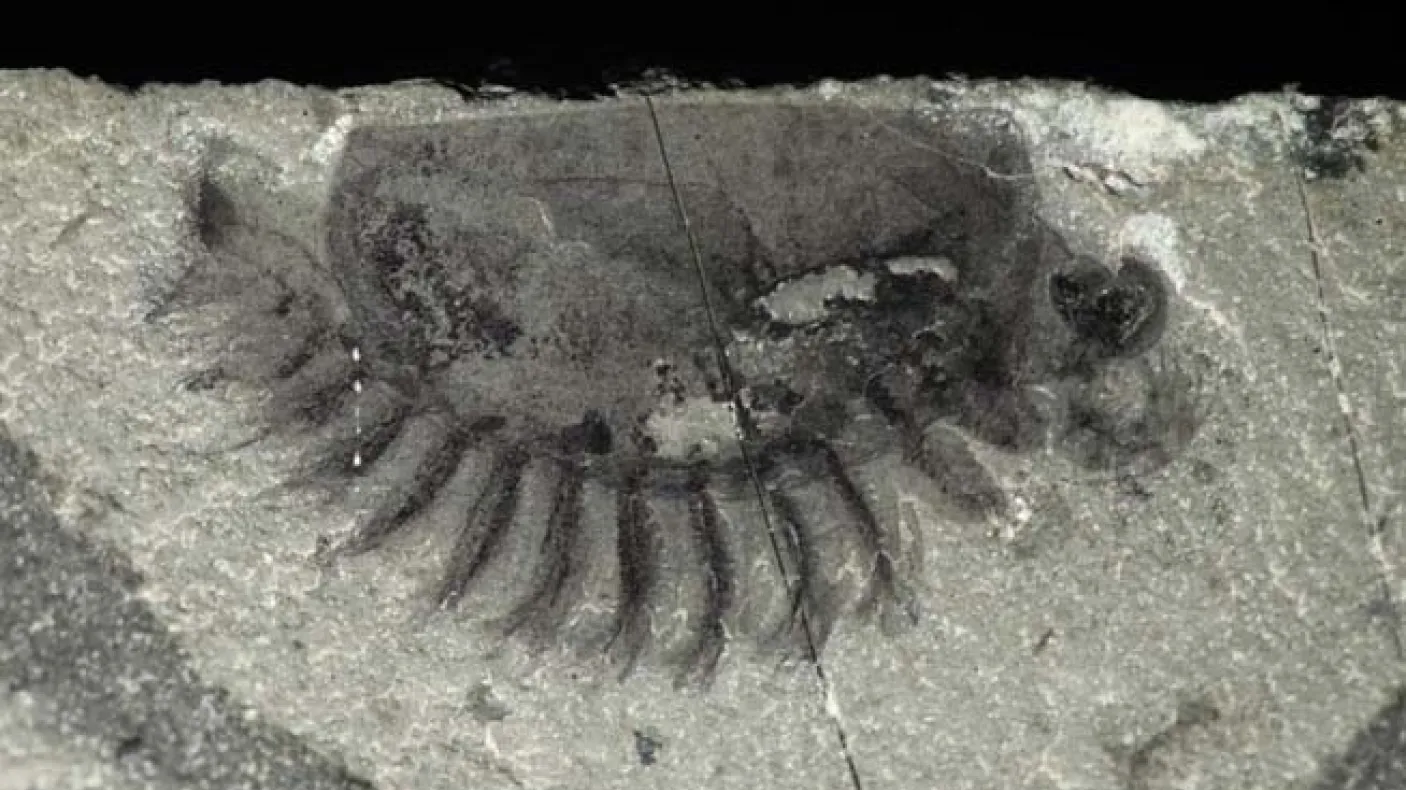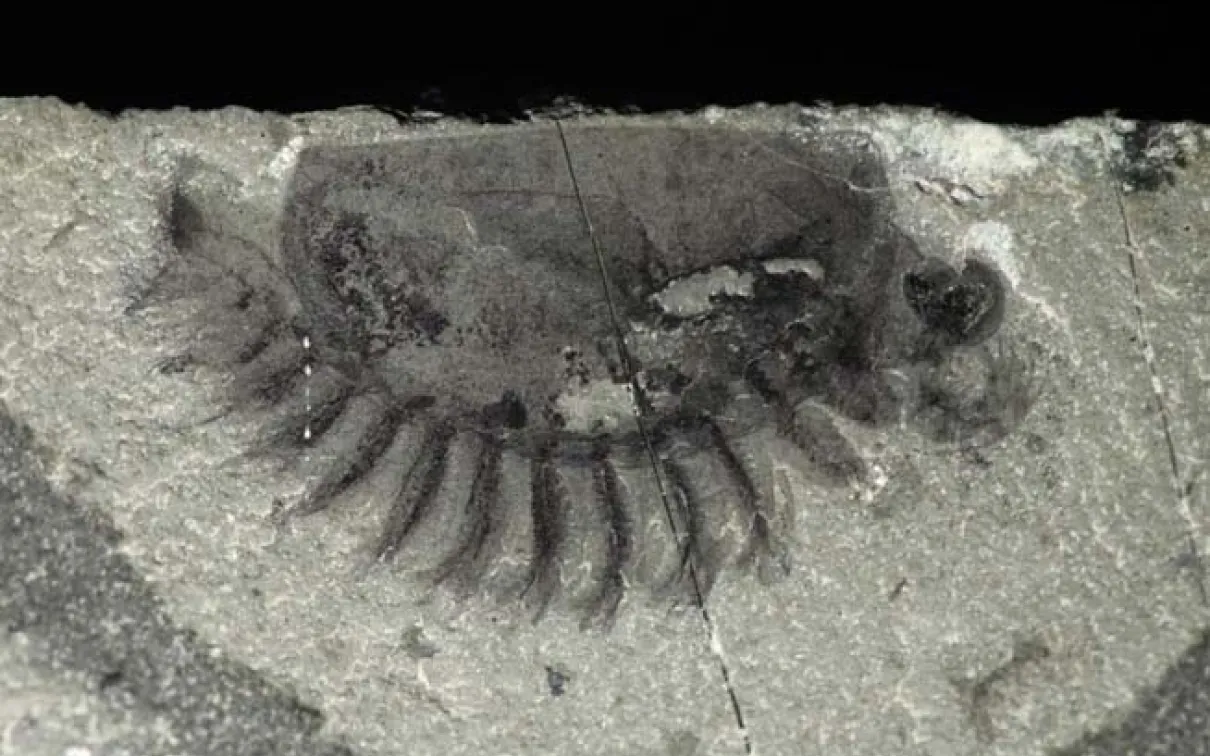Mighty Burgess Shale fossil site discovered in Kootenay National Park
Published
Categories
Blog Post
This new fossil assemblage is about the same age as the famous Burgess Shale deposit in Yoho National Park, and has the potential to become at least as significant. Since it was discovered by Charles Walcott in 1909, the Burgess Shale has remained the main source of information about Cambrian marine life – animals that lived about 505 million years ago.
The new Kootenay site is comparable to the Walcott Quarry in its exceptional diversity and abundance of fossils, and especially for the quality of preservation of soft-bodied animals – animals usually too fragile to fossilize well or at all. It contains many new fossil species not known to science.
We were surprised at the high diversity of organisms and the number of new species we found at the Kootenay site because we only spent about 15 days working there. We have only scratched the surface, so to speak, at this site. The possibilities for future discoveries at this site are huge, especially when we contrast this short visit with the more than 600 days of quarrying operations that together span a century of research at the Walcott Quarry. (See images of the Walcott Quarry today)
Visit the ROM's online Newsroom for more information about the new find.
Video diary of the discovery (find a shorter version without commentary at the bottom of page)
THE JOURNEY:
The story of the discovery of the new Kootenay site is first and foremost a human story of a group of researchers, students and volunteers working together to unlock a critical chapter in life history using fossils as the main source of evidence.
Discovering fossils can be an exhilarating experience, but it is not without challenges, especially in the Canadian Rockies. Hammer in hand, chisel in pocket, ready for action, we have to be prepared for frigid temperatures, scorching sun and roaring rain – basically all four seasons even in the middle of summer! Hours and often days can be spent in the field without a single find. Concealed in the rocks, fossils do not reveal themselves easily. We often have to work hard to extract them from the protective rock layers around them. Where are the long sought-after fossils? Patience, my friend!
Fieldwork is certainly one of the most exciting parts of my job as the ROM Curator of Invertebrate Palaeontology. The fossils we discover during fieldwork help our collections grow and are critical for research and education – exactly what museums are for. Fossils are fascinating time capsules of life on our planet and help us appreciate the immensity of time and the deep connections that exist among all life forms. Once at the ROM, the fossils we find will remain permanently protected from the elements, stored in cabinets for scientific studies or interpreted for the general public in exhibits. Once collected, a fossil will have a life of its own again, after being frozen in obscurity for millions of years.
Imagine unearthing for the first time the remains of creatures which roamed the oceans millions of years ago. Who knows – some could even be your distant great-great-great-great. .. . great cousin. Professional paleontologists like me certainly share the same thrill as amateurs do when a beautiful, rare or particularly complete specimen is discovered. One thing is for sure: you never know what you are going to get, and there are good and bad days no matter how well equipped, skilled or motivated you are.
Now imagine finding a motherlode of extraordinary specimens dating from the time when the first complex animals evolved and diversified on Earth. Well, this is what we think we have unearthed near the Alberta/British Columbia border in Northern Kootenay National Park close to Marble Canyon (see map below).
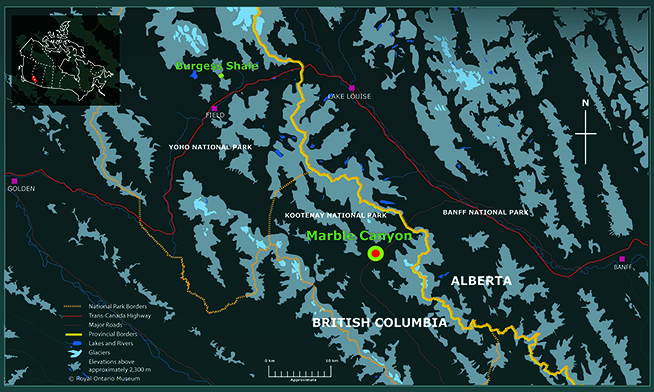
Map showing the new "Marble Canyon" site in northern Kootenay National Park, about 40 km southeast of the famous Walcott Quarry, the original Burgess Shale site in Yoho National Park.
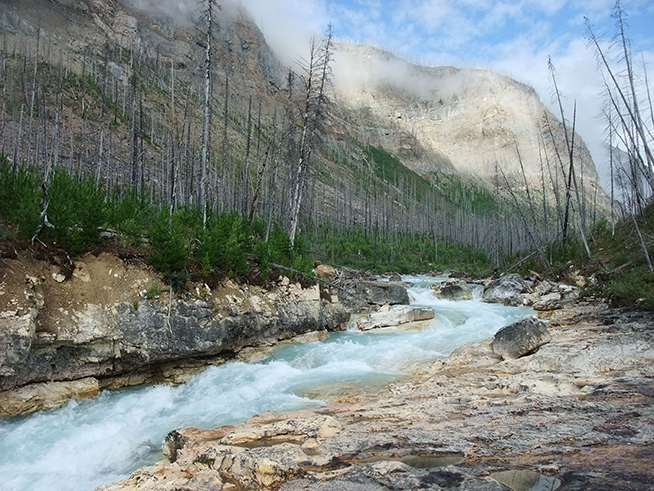
View of the Tokumm Creek at Marble Canyon.
Marble Canyon is named for its carbonate rocks that belong to the Cathedral Formation and that were deposited more than 500 million years ago. This particular canyon was initially carved by glaciers and further eroded by the Tokumm Creek.
You can visit this wonder of nature by taking a short trail that features interpretative panels explaining its geology (see image below).
While our fossil site is of approximately of the same age as the rocks at Marble Canyon, the fossils are from siliclastic shales – a different type of rock. The exact location of our fossil site near Marble Canyon has been kept secret so that Parks Canada can protect it.
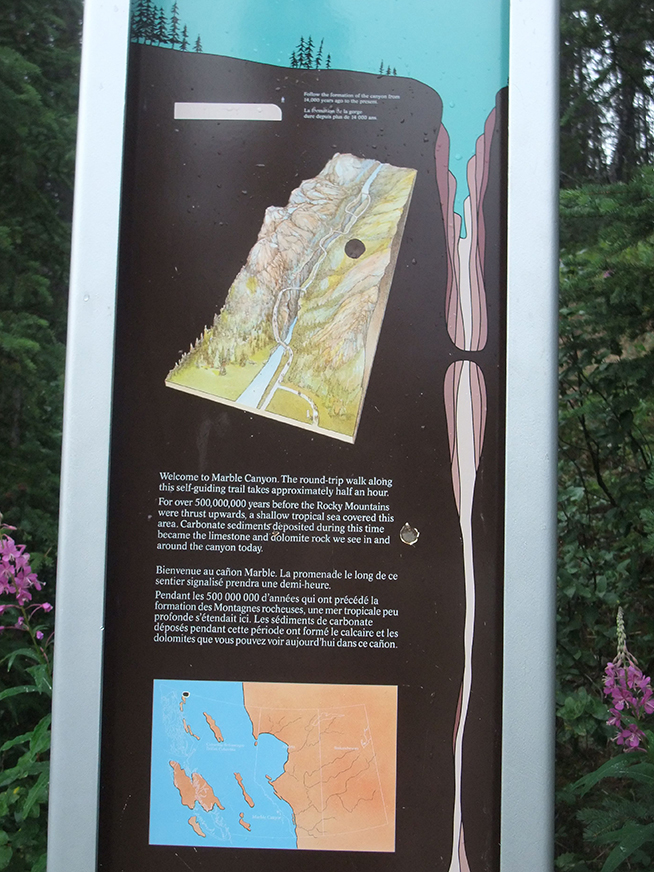
Information panel about the geology of the area for visitors to the trailhead at Marble Canyon.
The discovery of the new Kootenay site was made in the summer of 2012 by a ROM-led expedition during an initial phase of exploration done on foot and by helicopter. The field season had been planned more than a year in advance – like any scientific work done in National Parks, we first had to obtain a Parks Canada Research and Collecting permit. Our goal was to follow a particular geological feature called the Stephen Formation through the mountainous landscape. The Stephen Formation is home to the famous Burgess Shale Walcott Quarry and Trilobite Beds. We had a hunch that the Kootenay area could also be important, based on prior discoveries of fossils near Stanley Glacier, just a few kilometers away from Marble Canyon.

Helicopter-based field exploration in northern Kootenay National Park. The helicopter is in the background to the right.
On this trip we encountered countless spectacular vistas. Most of the areas of interest to us are over 2000 meters above sea level and are generally difficult to access on foot. Using a helicopter allowed us to make invaluable geological observations of vast areas in a short time and to detect safe passages for further ground reconnaissance. Looking at the rock faces, you can see layers which, in this part of the Rockies, represent sediments that accumulated at the bottom of tropical oceans close to half a billion years ago. These sediments were transformed into stones and uplifted by tectonic forces over millions of years. Glaciers then carved valleys into the rocks, allowing us to see the layers. Many of these layers are more or less horizontal – by following the contours of mountains at particular altitudes, we can literally follow the curves of particular ocean floors. In some specific rock layers of the Stephen Formation, we found the remains of invertebrate animals, now themselves transformed into stone. We eventually looked for more of these fossilized animals on the ground.
THE DISCOVERY
Back at the helipad, we entered the second phase of our expedition with a larger crew. We organized our field gear so that the helicopter could fly it in giant nets to our field site. In addition to the gear, we had to transport all of the food we needed to be self-sustaining for a period of 2 weeks in the mountains. Our destination was a spot of grass near a talus slope that had looked promising when we had visited it on foot earlier on.
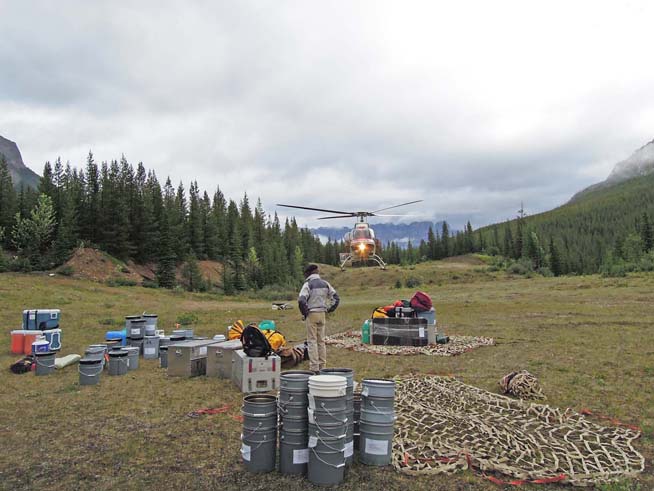
Sorting out field gear in nets at the field helipad (image courtesy of Gabriela Mangano)

Helicopter transport of equipment in nets to the campsite (image courtesy of Gabriela Mangano)
I am always amazed by the dexterity of the pilots who can land their machines in the most extreme places!
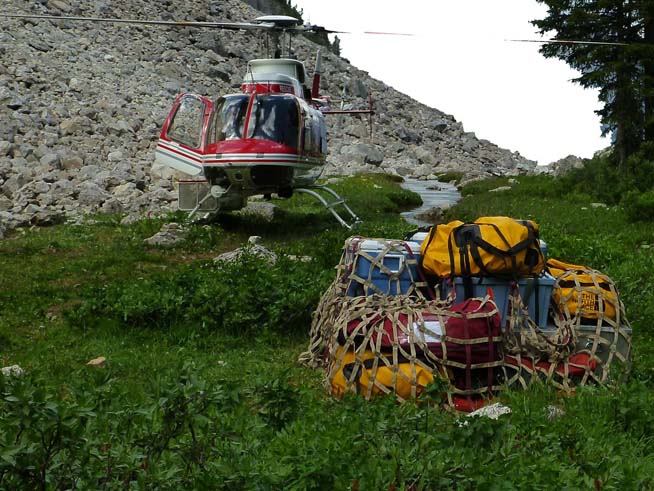
Helicopter at campsite with a load of equipment still in its net.
In the view of our camp below, the thin white posts support an electrical fence. The fence is to protect us against potential encounters with resident wildlife, including grizzlies and black bears. In fact, we did not see any bears – the only animals that approached our site were little pikas from the talus slopes next door.
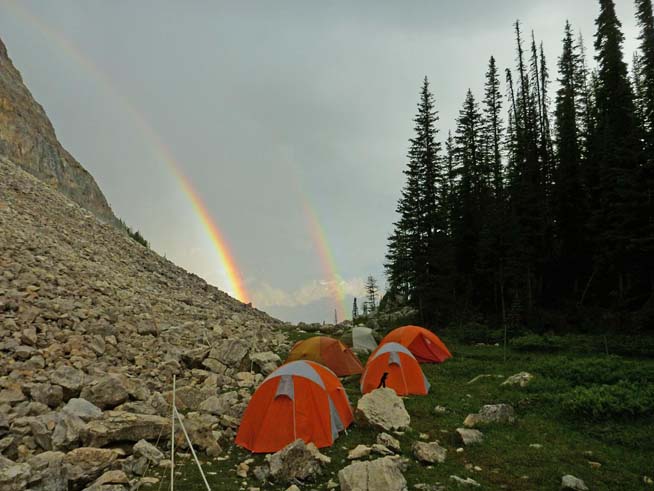
Royal Ontario Museum field campsite near Marble Canyon.
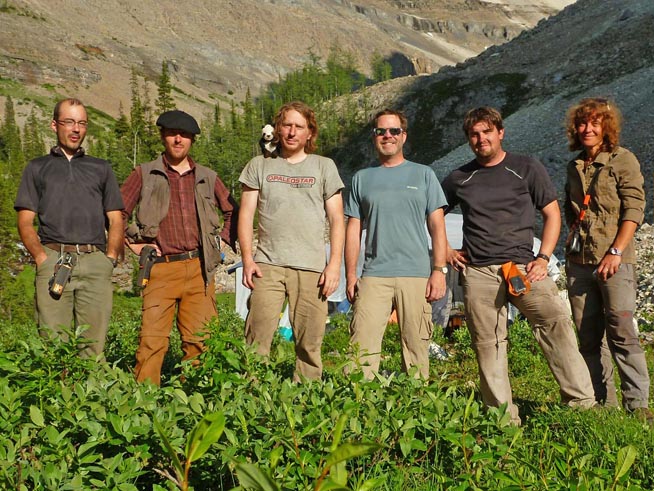
Burgess Shale 2012 field crew at Marble Canyon. From left to right, me, Cedric Aria (Ph D student, University of Toronto), Michael Streng (Uppsala University, Sweden), Robert Gaines (Pomona College, USA), Alan Byers (field assistant) and Gabriela Mangano (University of Saskatoon). Missing from this picture is Diego Balseiro, a volunteer from Argentina.
We spent a good part of our time exploring on foot around the campsite, walking on rocky slopes, taking pictures of rocky outcrops and making notes.
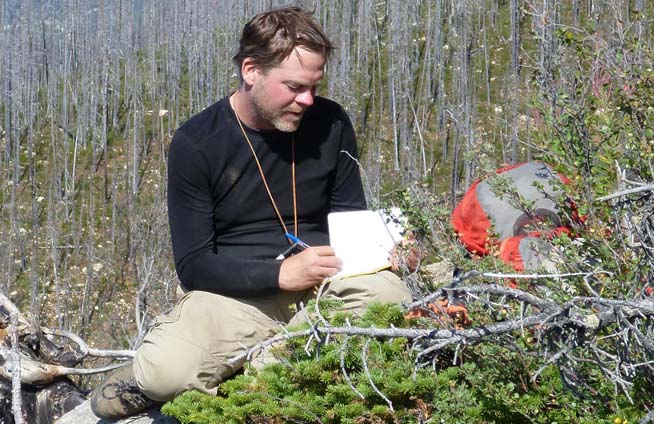
Robert Gaines from Pomona College taking geological notes in the field
The first fossils discovered on our trip were on loose pieces of rocks that had fallen from higher up in the mountains. They had been weathered by the elements probably for thousands of years, but that did not matter to us! Everybody in our team stumbled across treasures, and in a matter of a few days just doing simple "talus picking," we had found hundreds of specimens without much effort at all! I still remember exclamations of awe by my colleagues and field assistants every few minutes or so – it was unbelievable! These were very exciting times indeed. These fossils found in debris suggested that we had stumbled across something very special that still needed to be uncovered. Which particular rock layer or layers along this slope did these fossils come from? This is the same question that Walcott had had after discovering his first fossils on a trail in 1909. For more about Walcott's discovery see the Burgess Shale .
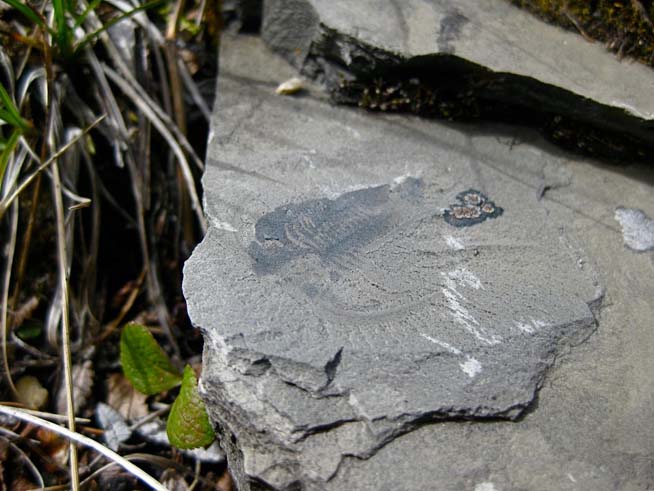
One of the first fossils discovered on talus slopes, a weathered specimen of Marrella splendens, a species better known from the Burgess Shale (image courtesy of Michael Streng).
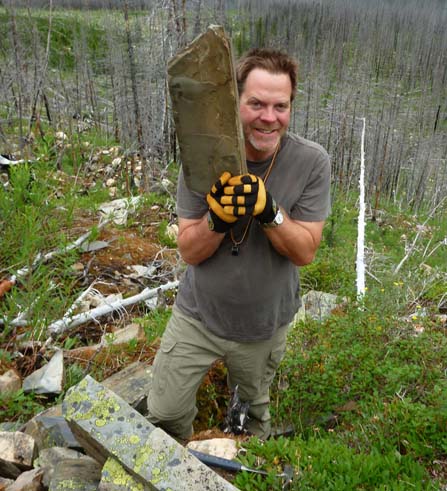
Robert Gaines discovers fossils along the rocky talus slope.
At times, we had to use a rock saw to safely extract particularly important fossils from the blocks where they were preserved. It can take several hours of hard work to extract a single specimen, but in this particular case (see the two images below) it was well worth it. The animal I was uncovering in that photo is a magnificent arthropod called Sidneyia inexpectans, and the specimen was just lying along the rocky slopes waiting to be discovered.
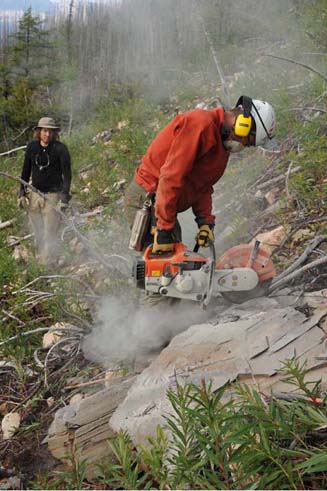
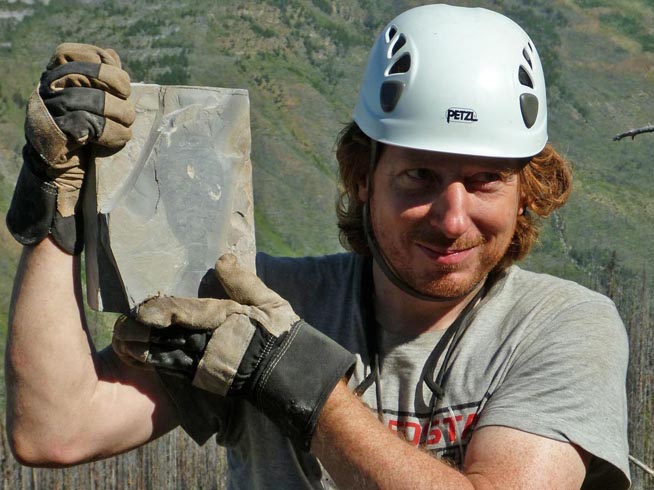
Michael Streng from Uppsala University (right) and me (left) extracting a fossil of Sidneyia inexpectans that Michael discovered along talus slopes. (Photo of J.-B. Caron courtesy of Robert Gaines).
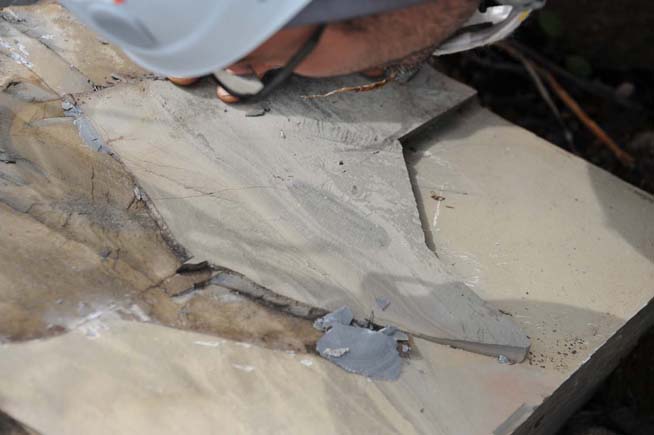
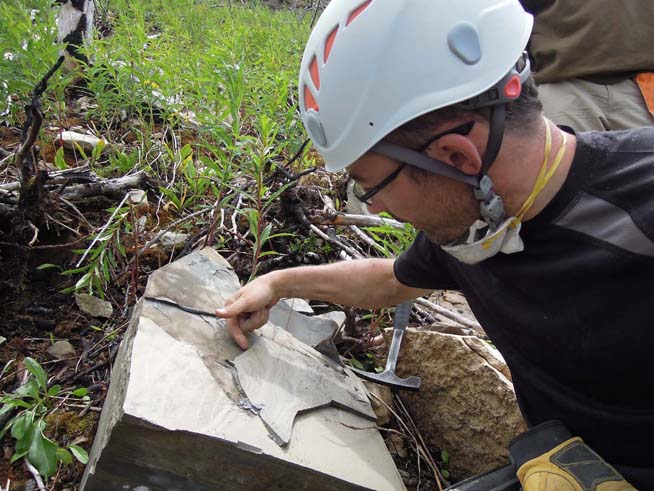
Two images showing the extraction of a fossil related to Naraoia, a species known only from China before we discovered this specimen (images courtesy of Robert Gaines (top) and Gabriela Mangano (bottom)).
We soon discovered the source of the fossils to be the outcrop where my colleague Gabriela Mangano is standing in the photo below.
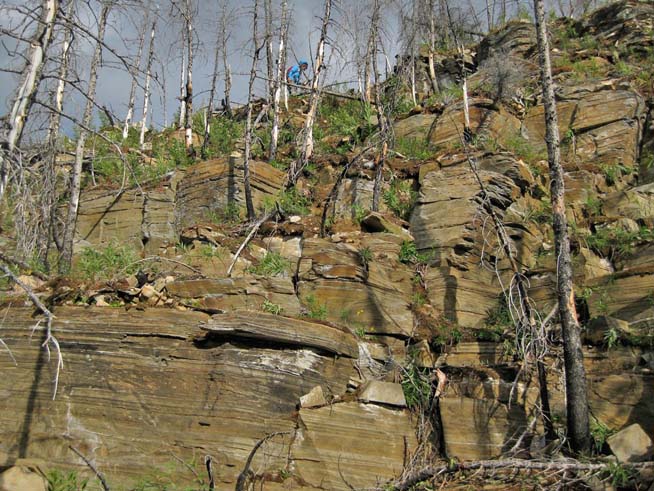
The Stephen Formation near Marble Canyon (image courtesy of Michael Streng).
We decided to start a small excavation to verify the source of the fossils, extracting small blocks directly from the outcrop and then splitting the blocks using chisels and hammers level by level. This process was quite frustrating at times because the blocks did not necessarily split very well and tended to shatter. We then had to examine all the fragments for fossils, but, to our relief, these efforts were usually not in vain. In total we collected more than 50 species and 3000 specimens from this little quarry!
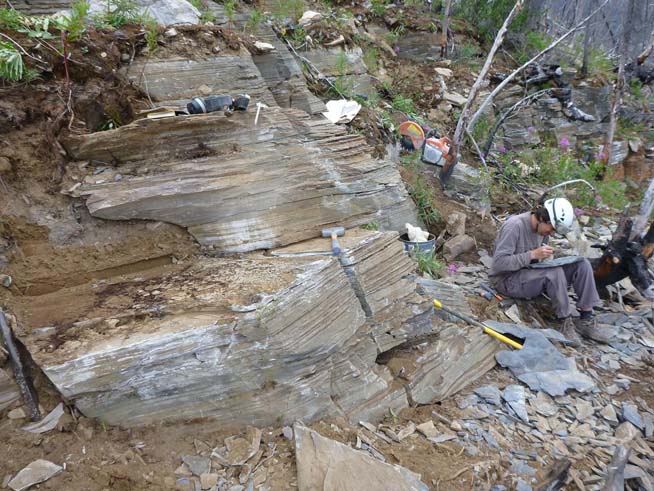
Quarry site showing fossiliferous layers. Diego Balseiro, a field volunteer from Argentina, is labeling fossils.
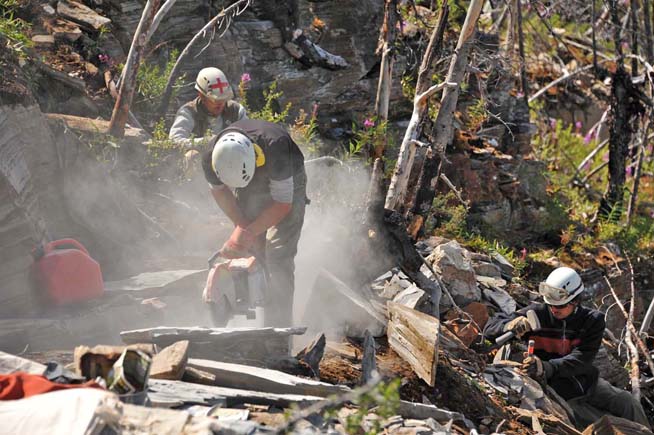
Here I am using a rock saw at the quarry site to extract fossils, while Cedric Aria, my Ph D student at the University of Toronto (back left) and Diego Balseiro, a volunteer from Argentina (right) use hammers and chisels (image courtesy of Robert Gaines).
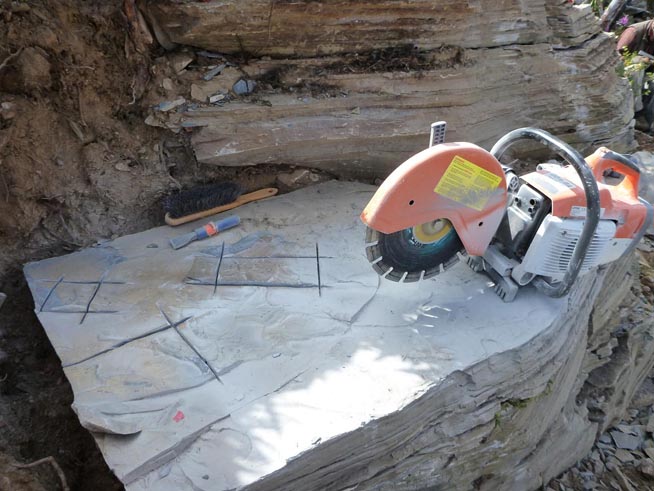
Rock saw marks are used to show where fossils are before they are extracted from the blocks.
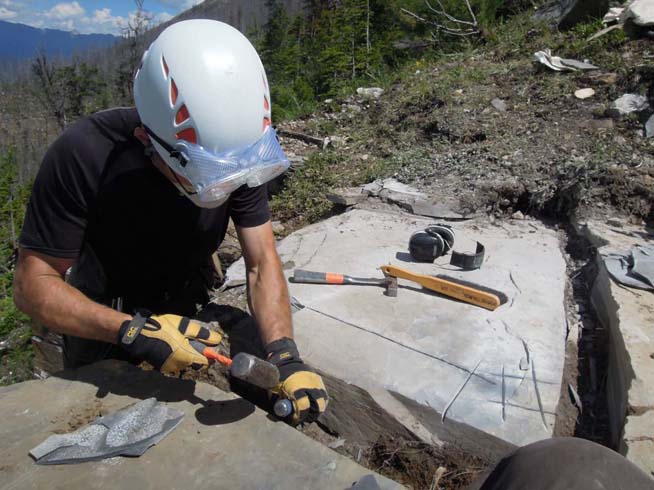
Extracting cut blocks using a hammer and chisel (image courtesy of Robert Gaines).
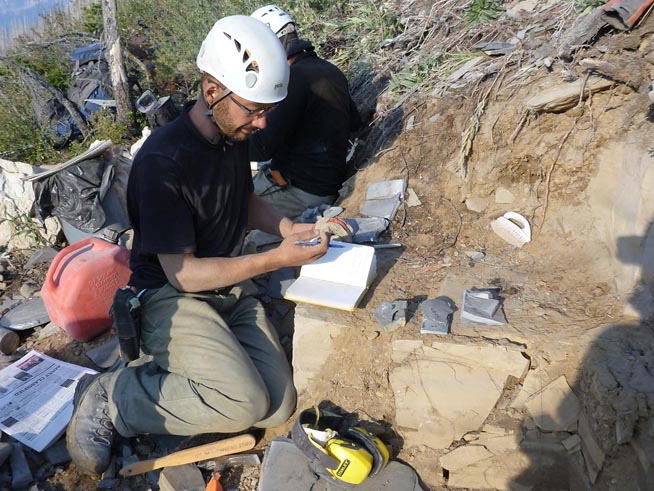
Identifying and inventorying fossils (image courtesy of Robert Gaines).
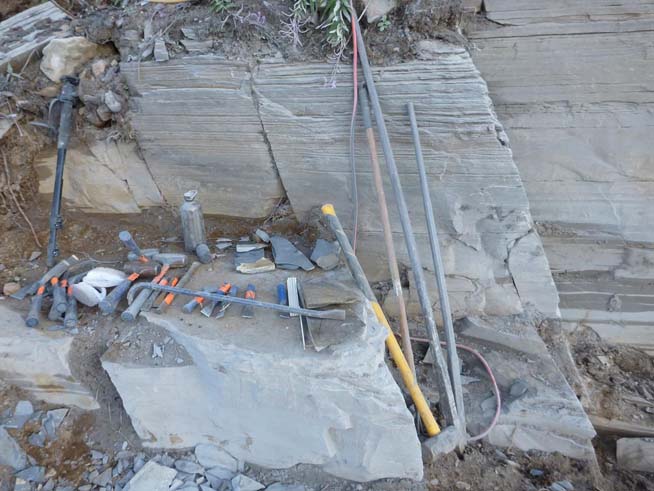
Basic tools of the trade: hammers, crow bars, chisels and mining bars.
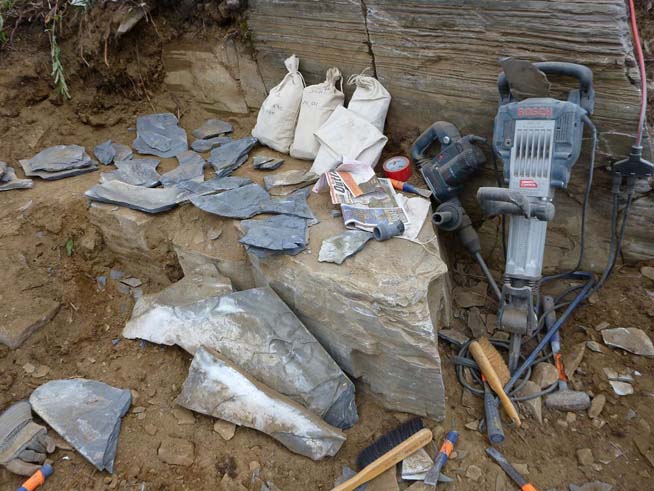
Field equipment including jackhammers, and fossils being labeled and wrapped before packing.
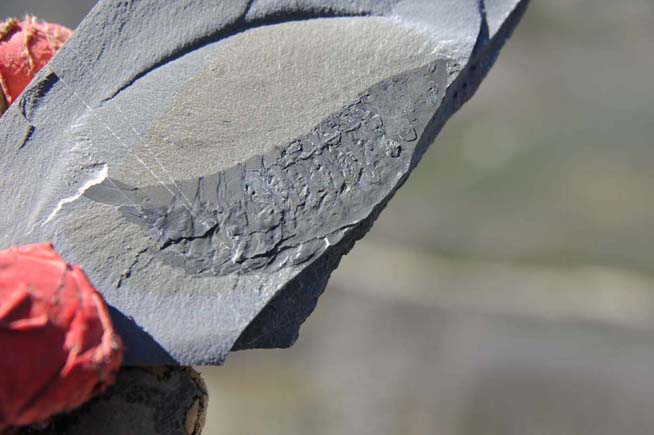
Field photograph of a newly discovered fossil (also shown in the image below), which turns out to be a new species (image courtesy of Robert Gaines).
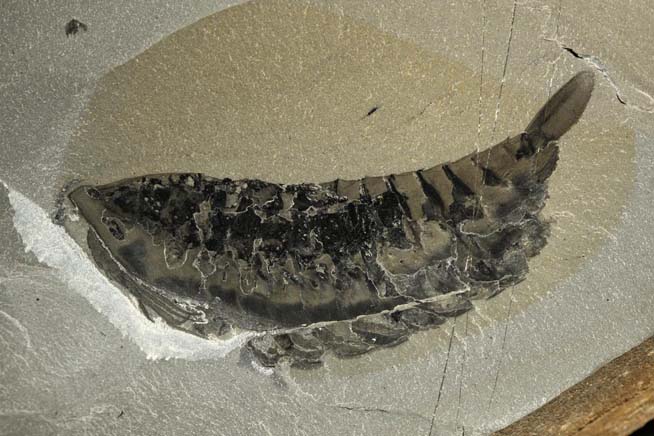
Image of the counterpart of the specimen photographed in the field, after preparation. This animal is related to Leanchoilia, an arthropod with a prominent pair of frontal appendages. On this specimens the appendages are bent along the ventral side of the animal.
Fossils that we extracted directly from the rock layers are not weathered like the many other specimens we found along talus slopes that had been split naturally and generally show beautiful details of the organisms’ anatomy.
We are now busy studying these fossils in detail. I can guarantee some fascinating new stories in the near future and I will make sure to relate them to you in a blog when they become published. There is still a lot of work to do in the collections we already have but we are confident that the biggest surprises still await us in the field.
We are really excited to go back to the site this summer with a larger crew in the hopes of unveiling even more secrets and treasures. Follow on Twitter with hashtag #BurgessShale and stay tuned for more stories!
To learn more about the Burgess Shale, visit our award-winning website:
burgess-shale.rom.on.ca
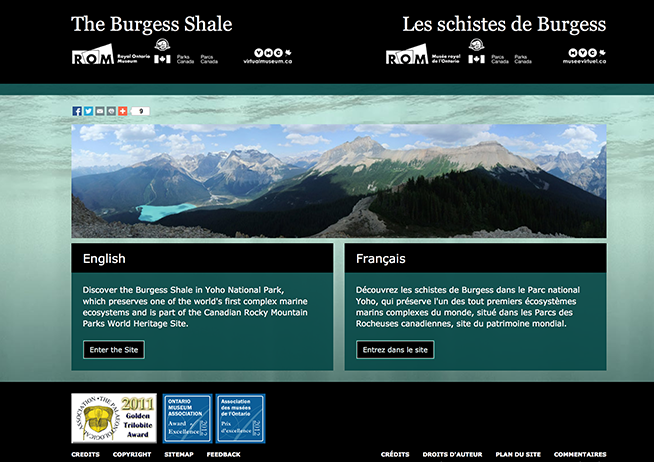
– Jean-Bernard Caron, Curator of Invertebrate Palaeontology and leader of the 2012 ROM field expedition
CREDITS
All fossil localities visited during the research are protected under the National Parks Act and all fossils and geological samples were collected under Parks Canada collection and research permit YNP-2012-12054.
We thank Todd Keith (Parks Canada) and Peter Fenton (Royal Ontario Museum) for logistical support.
Financial support for the 2012 expedition comes from the Royal Ontario Museum (JBC), Uppsala University and the Swedish Research Council (MS), Pomona College (RRG), Natural Sciences and Engineering Research Council Discovery Grants (to JBC #341944 and to GM #311727), and from the US National Science Foundation (to RRG #EAR-1046233).

